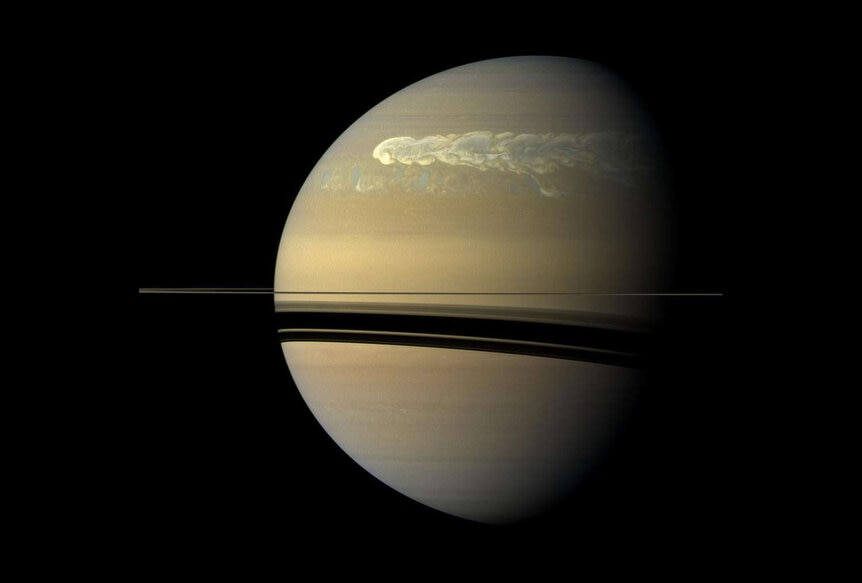This is the best time all year to see the ringed magnificence of Saturn

On Sunday night, August 1, the incredible beauty that is Saturn will be the closest it gets to Earth all year.
At that time it will be about 1,336,700,000 kilometers from Earth. That's still a long way — space is big, hence its name — but the planet will look incredible and gorgeous even through a small telescope.
We call this event opposition, because Saturn is opposite the Sun in the sky. Another way to think of it is that Earth is directly between Saturn and the Sun, so our two planets are as close as they can be. At any other time in its orbit the Earth will be farther from Saturn, making it appear smaller, which is why this is a great time to look at Saturn. You can't see the size directly by eye — it's still pretty far away, so it appears as a star-like dot — but any sort of magnification aid like binoculars will help. Bonus: because we're closest at opposition Saturn appears brightest, too.
Also, since it's opposite the Sun in the sky, it rises when the Sun sets, and sets when the Sun rises. It's up all night! So by the time the sky gets good and dark Saturn should be up high enough off the eastern horizon to see, and will continue to rise until shortly after 01:00 local time, when it's due south and as high as it'll get in the sky.
So it's up all night, as big as it gets, and as bright as it gets. Win win win.
Saturn takes about 29 years to orbit the Sun once. Earth is closer to the Sun and moves much more rapidly, completing an orbit in one year. If Saturn didn't move then opposition would occur once every Earth year. But Saturn does orbit around the Sun, in the same direction as Earth does, so we have to spend a little bit of extra time catching up to it. It's just like the hands on a clock; the big hand sweeps around once per hour, but the little hand moves a little too during that time, so the big hand doesn't meet up again with it for a little more than a hour.
That 29-year orbital period of Saturn is measured against the background stars, so we call it the sidereal period (from sidus, meaning "star"). The time it takes for Saturn, Earth, and the Sun to line up again is about 378 days (1.035 years) and that's the synodic period (from synod, from "related to a meeting", which is rather poetic).
I'll note that this doesn't mean you have to rush out and see Saturn at that very moment! It'll be bright and essentially up all night for weeks, even months (as it has been for a while, too). For example, back on July 22 it was 1,339,200,000 km away, and on August 15 it'll be 1,340,700,000 km. A million kilometers here or there hardly makes a difference (like, 0.1%), so no biggie if you can't get out to see it for a while. I'll note the next opposition of Saturn after this one is August 14, 2022.
If you do want to see it, go out once the sky is good and dark (roughly 10:00 p.m. local time, depending on your latitude) and look to the south/southeast. It'll be the bright "star" not far from the horizon.
… but be careful! Jupiter is approaching opposition as well (that's on August 19) and it rises an hour after Saturn does. It's much brighter — Jupiter is bigger and half the distance — making it a bit easier to distinguish from Saturn. If you spot a really bright object near the horizon, it's likely Jupiter, and Saturn will be a bit higher and to the right (for northern hemisphere viewers).
Mind you, waiting until later in the evening means both Saturn and Jupiter are up higher, and you don't want to miss the Big Guy either.
If you need help, try using some online planetarium software like Stellarium or The Sky Live (make sure you enter your location, too). Searching for "web planetarium software" will give you more sites if you like. I like the app Sky Safari, too.
With COVID still a big problem I don't recommend going to any star parties or such, though it's possible there might be local astronomical societies or observatories that will have telescopes out to see Saturn over the next few weeks. If you're looking to buy a telescope then my buying guide should help (and the links therein, too).
Having said that, it's hard to put into words what it's like to see Saturn through a telescope, especially for the first time. I've told this story many times, but my parents bought a cheapo department store telescope when I was kid (probably due to Saturn being at opposition then, and them seeing something about it in the newspaper) and set it up on the driveway. The moment I saw Saturn hanging there against the black of space, a perfect tiny ringed jewel, I knew I wanted to be an astronomer. Turns out, yup. I was right.
If you have a telescope, now is the time to use it! Jupiter, Saturn, the ever-changing face of the Moon… astronomy is a fantastic hobby.
You could say it's looking up.































